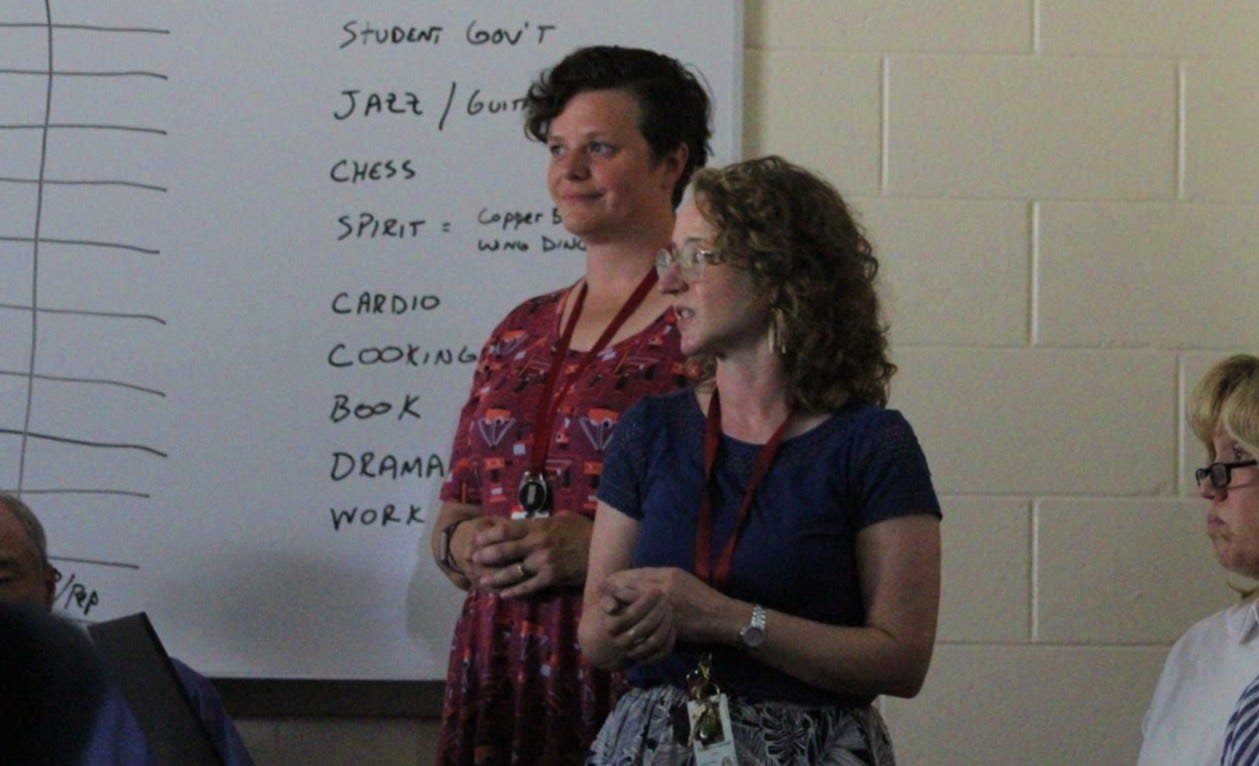Off to the Moon, Then to Mars
Woman from Trimountain and her cousin are both working to send humans to other planets
Photo courtesy of NASA
Will your grandchildren or great-grandchildren colonize Mars? An aerospace engineer who grew up in Trimountain and her cousin have been working on a NASA mission to help make that possible.
Artemis I is due to launch Tuesday from Cape Kennedy, headed for the moon. It’s the third scheduled launch; one in August and another in September had to be scrubbed due to technical issues.
Tess Falor, a Jeffers High School graduate, worked on the Orion space capsule that will ride on the SLS rocket that her cousin, Jesse McEnulty, helped design. The unmanned space capsule will test some technology required to send a future manned mission to Mars. Orion will travel within 60 miles of the moon, then go into lunar orbit 40,000 miles beyond the moon, the farthest that a human-rated spacecraft has ever traveled.
Falor, who graduated valedictorian of her high school class at Jeffers, works for Red Canyon Engineering and Software, a subcontractor for Lockheed Martin on the Orion space capsule. A member of Red Canyon’s electrical integration and test team, she worked on Orion’s propulsion system—the rockets that control how the spacecraft moves.
NASA’s Space Launch System (SLS) rocket with the Orion spacecraft aboard is seen atop the mobile launcher at Launch 39B at NASA’s Kennedy Space Center in Florida on Aug. 26, 2022. Artemis I mission is the first integrated test of the agency’s deep space exploration systems: the Space Launch System rocket, Orion spacecraft, and supporting ground systems. Photo credit: NASA/Eric Bordelon
Space Hooked Her Early
“I’ve been interested in space as long as I can remember,” she says.
In 10th grade, Falor took a career aptitude test, and aerospace engineering came up on top of the list. She did a Summer Youth Program at Michigan Tech on women in engineering and went on to study aerospace engineering at the University of Michigan. She earned a PhD at the University of California at Berkeley.
Falor and McEnulty’s fathers are brothers. Both were pilots, which McEnulty says probably influenced his career choice and his cousin’s. But she grew up in the Keweenaw, and he grew up in Colorado. They both decided to go into aerospace engineering. When Falor was part of a team developing an uncrewed Atlas-V rocket that launched from the Kennedy Space Center, McEnulty was working at the space center, and they got to share their experiences during the launch.
“She was viewing the launch from one location, and I from another, sending pictures back and forth,” McEnulty recalls. “I was so excited for her.”
Now McEnulty works at the Marshall Space Flight Center in Huntsville, Alabama, where he tested the SLS rocket’s thrust vector control system, which moves the rocket engine nozzles around to steer the vehicle. He also supports launches from the control room in Huntsville, analyzing data from the thrust vector control system prior to launch and during flight.
So he won’t be at the launch in person on Tuesday. He’ll be doing a 12-hour shift in the control room in Huntsville, monitoring every technical detail of the launch. But he doesn’t regret not being at Cape Kennedy.
“Our control room has nice big screens,” he says. “And frankly, I prefer actually working the launch and being directly involved as opposed to just watching, even in-person.”
Falor and McEnulty were delighted to find themselves working on different ends of the Artemis project.
“I've always found it interesting that our work is at opposite ends of the rocket, hers being up on the clean, pointy spacecraft end, and mine being down at the blunt, oily fire producing end,” McEnulty says.
A test version of NASA’s Orion spacecraft is loaded into the well deck of a U.S. Navy ship in preparation for the ninth in a series of tests to verify and validate procedures and hardware that will be used to recover the spacecraft after it splashes down in the Pacific Ocean following the agency’s Artemis I mission. The first in an increasingly complex series of missions, Artemis I will test the Space Launch System rocket and Orion as an integrated system prior to crewed flights to the Moon. Photo credit: NASA/Pete Reutt
Life Off Earth
Why is it important for missions like Artemis to take astronauts to the far reaches of space?
“I think a lot about the far future,” Falor explains. “There are threats to earth – asteroids, natural disasters, man-made problems like climate change. I would like humanity to be able to live in different locations, off earth. It’s important for us to explore and learn to live elsewhere, to keep humanity going.”
NASA aims to follow Artemis I with more trips to the moon. Artemis II, currently scheduled for 2024, will be crewed and fly around the moon. Artemis III, planned for 2025, will land a woman and a person of color on the moon for the first time.
At the same time, at Michigan Tech, Professor Greg Odegard is leading a multi-university research project to develop lighter, stronger materials for the future Mars mission. Odegard, who holds the John D. Halquist Endowed Chair in Computational Mechanics at Tech, heads the Institute for Ultra-Strong Composites by Computational Design (US-COMP), funded by NASA’s Space Technology Mission Directorate.
Affordable deep space exploration will require lighter and stronger building materials for the manufacture of next-generation transit vehicles, habitats, power systems and other space exploration systems. US-COMP is working to develop and deploy a carbon nanotube-based, ultra-high strength, lightweight aerospace structural material that will enable future spacecraft to take crews far beyond the moon.
Maybe to Mars.
How seniors can stay in their homes as they age
Local group raising awareness of “aging in place” safety strategies
You bought your home in your 30s or 40s. Decades passed, as children’s footsteps clattered up and down the stairs; cabinets were packed from top to bottom with food, plates, glasses, cooking utensils. Lovely throw rugs decorated the floors. You could find your way anywhere in the dark.
Then suddenly you are in your 70s or 80s. The children are grown and gone. Stairs are getting harder and harder to climb. You can’t reach the top shelves of your cabinets without climbing on a precarious step stool. You have trouble kneeling down to get that pan out of the oven. It’s hard to get in and out of the bathtub. You stumble in dark hallways and trip over throw rugs.
Will you have to leave your home and move into an assisted living facility?
Craig Waddell hopes to help you stay in your home as you get older. A Houghton City Councilman, Waddell has formed a group in the Copper Country to educate and support people who want to age in place.
More than 23% of people in the Western UP are 65 or over, significantly higher than the national average of 16.9%.
A recent AARP survey found that 77% of older Americans want to age in place, meaning live in their own home safely, independently and comfortably. However, most houses and apartments are designed for young, able-bodied adults and don’t meet the needs of older residents.
Last week, Waddell invited Michigan AARP Associate Director Karen Kafantaris to talk about aging in place and AARP’s HomeFit program. Kafantaris pioneered this AARP initiative. Working with an occupational therapist and principles of universal design—defined as an environment designed to be accessed, understood and used by people regardless of their age, size, ability, or disability—Kafantaris developed the HomeFit program.
HomeFit helps seniors identify barriers to remaining in their homes as they age and suggests ways to modify that home for safety and comfort. The HomeFit guide can also help elected officials, policymakers and local leaders learn about and advocate for the housing options that communities require, so residents of all ages can live safely and comfortably—and thrive.
It is available as a free booklet or can be downloaded as a PDF from AARP.
By 2030, Kafantaris said, one in five Americans will be over 65 and living alone. The HomeFit guide offers more than 100 tips to make their homes “aging-friendly.”
Room by room, she described the issues facing older people living in homes built for able-bodied young adults: stairs, high cabinets, lighting, tubs that are hard to climb into, throw rugs, door knobs and cabinet handles that can be difficult for aging hands to use—the list goes on and on. But there are solutions—some of them easy and inexpensive, others requiring more investment and professional help.
Quick fixes include:
Replace throw rugs or put non-slip pads under them
Put nightlights in every room
Carry a cell phone wherever you go
Keep flashlights in every room and check batteries regularly
Make sure you have large, easy to see address numbers on your house to enable first responders to find it quickly
Secure electrical cords along walls, so they aren’t a tripping hazard
Use a simple tool known as a grabber to get items off high shelves
Have lights at both ends of hallways and stairs
Replace lightbulbs that are too dim or too bright
Keep a working fire extinguisher in the kitchen
More expensive, but important:
Have grab bars installed in the bathroom, by your bed, wherever you might need them
Replace cabinet knobs with D-shaped pulls
Replace over-the stove microwave with one that sits on the counter
Replace doorknobs with lever-style handles
Have CO2 and smoke detectors installed on every floor
Replace light switches with rocker switches
Invest in no-touch lamps
Install non-skid strips on uncarpeted stairs
Install a video doorbell
Build a no-step entrance or install a ramp
Replace traditional tub with a walk-in shower
“You can stay in your home as you age,” Kafantaris said. “It just takes some thought, some planning, and some modifications.”
Parade of Nations 2022
The Keweenaw area community celebrates the diversity of cultures in the area each year. This year, not only was there the parade, but also an opportunity to take home foods from international cultures.
Millages, Critical Thinking, and Rainbow Flags
Residents voice opinions while librarians seek more certain future for Hancock Library
Parents and other community members gathering for the Aug. 22 meeting. Photo by Juxta Sprague.
With more than ten minutes until the meeting’s start, chairs are scarce as parents, teachers, librarians, and other community members make their way into a small room within the Hancock Middle School. One person hands out buttons that read "Support the Hancock Library". The Hancock Public Schools Board of Education calls their Aug. 22 meeting to order with nearly a dozen still standing, overflowing into the adjacent kitchenette and hallway.
Katrina Linde-Moriarty, director of the Portage Lake District Library, presenting to the board and public. Photo by Juxta Sprague.
Katrina Linde-Moriarty, the new director of the Portage Lake District Library (PLDL), gave a presentation to the board to help illustrate the history, achievements, and possible future of collaboration between PLDL and the Hancock Public Schools.
In 2018, a contract was established to have PLDL manage the Hancock School Public Library (HSPL) which had until then been run at limited hours and staffed by volunteers. Although still new to their role, Linde-Moriarty was excited by the progress that had been made during the initial four years of the contract.
548 new library cards were created, checkouts increased by 166% (average of 10.5 checkouts per user for 21/22 year), 5513 new items were added, and library visits increased by an impressive 392%.
HSPL also succeeded in applying for grants and soliciting donations to help fund the services, materials, and improvements of the library. A grant of $212,000 was recently awarded jointly to HSPL and the school district through the Michigan Department of Education literacy program, substantially much more than the ~$29,000 initially requested. Linde-Moriarty has indicated that the grant will fund the program and cover much-needed improvements for the library including new programming, shelves, furnishings, books, maker-space equipment, and a complete overhaul of three outdated non-fiction sections of the library.
Linde-Moriarty offered three possible next steps for the relationship between Hancock School Public Library and the PLDL.
Extend the current contract. Linde-Moriarty noted that without increasing the financial commitment the level of service would decrease over time.
Continue the contract but require the municipalities to levy a millage to support the library.
Pursue a PLDL millage for all the municipalities of Hancock Public Schools to match the 1.96 mils of Houghton and Portage Township making HSPL a "branch" of PLDL allowing library cardholders to check out materials at both locations.
Linde-Moriarty concluded by requesting the current contract be extended one fiscal year with a millage increase from 0.3 (~$73,000) to 0.4 (~$84,000) in order to offset staffing costs and to reinstate the Hancock School Public Library Advisory Committee to improve transparency and ease of communication between the Board of Education and PLDL.
Handouts and slides for the HSPL contract renewal are available on the PLDL website.
Nearly a dozen individuals made visitor comments to the board.
Amanda Lutey, a resident of Hancock, thanked the Board for supporting the library and making it "accessible to all".
Amanda Lutey (left) and Faith Morrison (center) both delivered comments to the Hancock Board of Education. Photo by Juxta Sprague.
Faith Morrison, a recently retired Professor from Michigan Tech, delivered a statement on the importance of libraries in teaching critical thinking and problem-solving.
"A good library should have something to offend everyone," Morrison read.
A parent said that the "Library had stuff that was not appropriate for my son," and that “parents don't like material being shoved in the face of their kids".
The individual declined to provide further comment or be identified for this story.
Allyson Jabusch speaks to the Board of Education. Photo by Juxta Sprague.
Allyson Jabusch, a retiree from Michigan Tech, said that "The library contract saved the day" and encouraged the Board of Education to extend the contract. Jabusch also encouraged community members to volunteer at schools and libraries.
Another individual responded to Jabusch saying "We all have different views on the law".
The individual did not clearly identify themself to the board.
Chris Heikkinen, a former member of the Hancock Board of Education, applauded the work of the current school board. In reference to a pride month library display at HPSL, he stated “This material doesn’t have a place in a display in a public library”.
"Parents are the ultimate authority [and they are] trying to stop the kidnapping of their kids' innocence,” Heikkinen said.
He concluded his comment by asking the Board how they will build and maintain institutional trust.
“Libraries are one of the last places somebody can go without having to pay money,” William Keith, an associate professor at Michigan Tech, said. “A place where everyone is welcome.”
Keith also voiced support for the library Advisory Committee proposed by Linde-Moriarty to ensure transparency.
Stephanie Flint, a resident of Hancock, shared her experience of "rediscovering the [Hancock] library".
She stated that "InterLibrary loan has been great" and that the library has offered "good materials for people on a budget".
Flint expressed hope that the contract would be renewed.
Dillon Geshel, former director of the PLDL, noted that most public school libraries have disappeared in Michigan due to state legislation and that HSPL is one of the few remaining. Geshel encouraged the Board to "think about why [HSPL] has been as successful as it has [during the four-year contract]."
Editor’s Note: Geshel is a member of Copper Beacon’s Board of Directors.
Steve Raasio, a parent of seven former Hancock students, said that "political stuff [shouldn't be] involved anywhere" in reference to rainbow flags being displayed at the library. He stated that he'd prefer to see the library "fall on its face" than promote "political ideologies".
Raasio noted that he does not personally use the library though some of his adult children do.
Susan Autio, the Circulation Manager at PLDL, said that she oversees the committees that curate library content, and values diversity in the selection there.
"I buy books I find personally offensive," Autio said.
Autio, in reference to the HSPL, stated that "kids are endlessly checking out books" and that she "would be so sad to see this end".
The PLDL and HSPL contract has already been extended twice and is again entering the final months. The board did not vote on its future at this meeting. Their next regular meeting is scheduled for Sept. 19 at 5 p.m.
Second-grade teachers Genevieve Nordmark and Becky Garnell present on computer science and STEM education. Photo by Juxta Sprague.
Second-grade teachers Genevieve Nordmark and Becky Garnell also delivered a presentation to the Board of Education on the importance of computer science and STEM education for student careers, future wages and college attendance. They emphasized that many valuable skills such as problem-solving, critical thinking, and communication are taught through computers, robots, 3D printers, and other technologies in a way that is exciting, fun, and accessible to students.
Ben Larson also gave a brief oral presentation to the board to encourage fundraising through alumni outreach. Larson made several suggestions such as finding naming opportunities and an "Alumni Distinction Honor Group" to get alumni of the Hancock Public Schools excited about making donations or gifts to help fund improvements to the school district.
Stopping European frog-bit
By Connor Ford and Erin Mauk
Michigan’s Upper Peninsula is uniquely surrounded by three of the five Great Lakes and is home to many ecologically diverse and unique Great Lakes coastal wetlands, rivers, shorelines and lakes, in addition to hundreds of natural aquatic attraction sites across 15 counties. Each year, thousands of visitors flock to the UP to take advantage of these sites for recreation including kayaking, boating, fishing, swimming, and hunting. Increased tourism has resulted in an increased introduction of new aquatic invasive species to the region. These species threaten the quality of tourism and ecological health of Michigan’s UP.
European frog-bit in the field. Photo provided by Sigrid Resh
One of these new species is European frog-bit, a free-floating aquatic invasive species that can form dense mats, hinder recreational activities and disrupt the movement of waterfowl and fish. Within Michigan’s UP, the prevention and management of this species is a focus of the organizations within the Cooperative Invasive Species Management Areas, one such organization is KISMA.
Who is KISMA?
Locally, the Keweenaw Invasive Species Management Area (KISMA) has received funding to survey for and educate about invasive European frog-bit.
“KISMA is an acronym for the Keweenaw Invasive Species Management Area, which is a specific Cooperative Invasive Species Management Area (CISMA) that covers Baraga, Houghton and Keweenaw Counties,” said Sigrid Resh, KISMA’s coordinator, “CISMAs, in general, are tasked with providing education and outreach to our stakeholders for the prevention, identification and management of invasive species across jurisdictional boundaries.”
Resh also said that “KISMA has 22 partners ranging from Tribal, Federal and State entities, such as the Keweenaw Bay Indian Community, the National Forest Service, the National Park Service and the Department of Natural Resources, to regional and local conservancy groups such as The Nature Conservancy, Gratiot Lake Conservancy and the Keweenaw Land Trust. KISMA also works with private landowners and managers within our tri-county area.”
KISMA’s organizational partners.
What is European frog-bit?
One of the new invaders that has made its way to the UP is European frog-bit (Hydrocharis morsus-ranae), a watch-list species prohibited here in Michigan, according to the State of Michigan’s website. European frog-bit is a free-floating aquatic plant that resembles a small lily pad, usually the size of a quarter, and can be found in low-wave action, sheltered sites such as ponds, wetlands, inland lakes, or coves and bays of a river system. It can form dense mats across the water surface while creating a tangled, interweaving mess of roots below. It is currently found in Chippewa and Mackinac Counties in the eastern UP, in addition to northeastern Wisconsin, not far from the Michigan border, according to a 2021 technical report from the State of Michigan regarding the status and strategy for addressing European frog-bit.
European frog-bit plants resemble miniature water lilies. Photo from Michigan.gov/invasives
Why manage this species? Why care?
European frog-bit has numerous impacts on the landscape. According to the state’s technical report, ecological factors include habitat degradation for breeding waterfowl, elimination of fish passage for spawning species, and reduction of light and dissolved oxygen in the water column. Frog-bit also can get caught in boat propellers and impede boat traffic, or collect on kayaks and paddles. Just like other aquatic species, this invader spreads primarily through fragmentation, caused by recreational activities like boating or duck hunting. It does not take much for a segment or whole plant to stick to the side of a boat, a piece to be chopped up and left on a propeller, or stuck to the side of a pair of waders.
“European frog-bit may act as an aquatic hitchhiker, so boaters, anglers, and hunters can unintentionally contribute to its spread,” the state’s technical report reads.
Plants can form dense mats, often among cattails or other shallow-water vegetation. Photo from Michigan.gov/invasives
What’s being done?
KISMA is surveying local waterways for signs of European frog-bit in cooperation with other UP CISMAs, the Upper Peninsula Resource Conservation and Development Council, and the state of Michigan.
“This is the second year of this species-specific project, and we have not found any European frog-bit in the KISMA yet,” Resh said. “However, it has been found near the Wisconsin-Michigan border and in the eastern UP, so spread to our area is highly possible if our locals and visitors are not aware of the importance of prevention measures, that is, to clean, drain, and dry their aquatic recreational gear and equipment.”
Resh said they know that not finding European frog-bit so far doesn’t mean they can let their guard down.
“Early detection will be the key to protecting our coastal habitats for our native aquatic species. The more people who know what to look for the quicker our response can be if it is found,” Resh said.
CISMAs are also providing outreach–via workshops, social media, and interviews centered on proper identification and prevention techniques. According to the state’s technical report, in the eastern UP, where European frog-bit has been found, it is being hand-removed. Plants are carefully collected from the water, drained and disposed of in an approved landfill (eliminating the risk of re-introduction elsewhere). Proper decontamination of all field gear always follows survey and removal efforts.
Is prevention in the Keweenaw still possible?
According to the state’s technical report, proper treatment of invasive species will help control efforts; however, prevention techniques by recreators are the most economical tools available to stop European frog-bit, sometimes referred to as EFB.
“Over a five-year period in the Town Farm Bay in Vermont, 55.9 tons (50,711.63 kg) of EFB were removed at a cost of $79,000 and 6,208 hours, reducing EFB cover to less than 6%,” according to the state’s technical report.
As an invasive species occupies more area more economic resources and time are required to manage it. The most cost- and time-effective stage is the prevention stage, followed by eradication, then containment. Asset-based prevention requires the most money and time because the invasive species has become abundant and widespread – credit: modified from Hobbs and Humphreys 1995 and DEPI 2013
It is crucial to clean recreational gear, drain livewells and bilges, and dry all watercraft and associated equipment to avoid having to remove adult mats of the plant from recreational and natural areas later. This “Clean. Drain. Dry.” protocol is vital when moving from one water body to another. For more information about how recreators, hunters, and boaters can prevent the spread of aquatic invasive species, visit https://stopaquatichitchhikers.org/prevention/.
To learn more about European frog-bit visit Michigan.gov/invasives or to locally get involved contact kisma.up@gmail.com or visit KISMA’s website at https://www.mtu.edu/kisma/.
Locals organize pro-choice demonstrations
Follow-up planned on 4th of July
Protestors on June 25 in Houghton’s Veterans Memorial Park. Photo by Katie Plummer.
Following the official announcement of the U.S. Supreme Court’s official decision to overturn Roe v. Wade, and so return abortion decisions to state governments, protests have sprung up across the country, including in Houghton.
Another reproductive rights protest is being planned for 3 p.m. on July 4, also at Veterans Memorial Park.
Photo courtesy of Davi Sprague.
Photo by Katie Plummer.
Photo courtesy of Davi Sprague.
Photo courtesy of Davi Sprague.
Photo courtesy of Davi Sprague.
Photo by Katie Plummer.
Photo by Katie Plummer.
Photo by Katie Plummer.
Peace poles planted in Hancock
Mary Babcock, City Manager, and the Hancock City Council are eager to represent the City of Hancock as an International City of Peace. Attending many of the meetings with the local interfaith group, Keweenaw Faiths United, they moved forward with purchasing two Peace poles. One was placed right at the entrance to the Hancock Campground, which displays the words “May Peace Prevail on Earth” in English, Braille, French, Croatian and Italian. The other was placed at the Labyrinth near the Ramada, displaying those words in English, Finnish, Ojibwa, Irish (Gaelic), and has a Braille plaque as well.
The Peace pole by the Labyrinth in Hancock, shows the English and Ojibwemowin prayers of peace. Photo by Miriam Pickens.
They selected those languages to honor the early settlers of this area. There are plans for a set of Peace poles in Houghton as well.
There will be a dedication on the evening of Wednesday, Sept. 21, the International Day of Peace, observed around the world, as declared by the United Nations. Hancock and Houghton became International Cities of Peace last fall, with a mission to continue to be a welcoming community and to strive to do more.
Linda Belote (left) and Miriam Pickens carry Cities of Peace banners for Houghton and Hancock in the Bridgefest 2022 parade. Photo by Joshua Vissers.
Bridgefest Parade 2022
Photo Gallery
Hello! I really enjoyed getting out and taking photos of the Bridgefest 2022 parade Friday night. Below are a few of my favorites.
Stopping European frog-bit
Avoid bringing this harmful species to the Keweenaw area
By Connor Ford and Erin Mauk
European frog-bit in the field. Photo credit Sigrid Resh.
Michigan’s Upper Peninsula is uniquely surrounded by three of the five Great Lakes and is home to many ecologically diverse and unique Great Lakes coastal wetlands, rivers, shorelines and lakes, in addition to hundreds of natural aquatic attraction sites across 15 counties. Each year, thousands of visitors flock to the UP to take advantage of these sites for recreation including kayaking, boating, fishing, swimming and hunting. Increased tourism has resulted in an increased introduction of new aquatic invasive species to the region. These species threaten the quality of tourism and ecological health of Michigan’s UP.
One of these new species is European frog-bit, a free-floating aquatic invasive species that can form dense mats, hinder recreational activities and disrupt the movement of waterfowl and fish. Within Michigan’s UP, the prevention and management of this species is a focus of the organizations within the Cooperative Invasive Species Management Areas, one such organization is KISMA.
Who is KISMA?
Locally, the Keweenaw Invasive Species Management Area (KISMA) has received funding to survey for and educate about invasive European frog-bit.
“KISMA is an acronym for the Keweenaw Invasive Species Management Area, which is a specific Cooperative Invasive Species Management Area (CISMA) that covers Baraga, Houghton and Keweenaw Counties,” said Sigrid Resh, KISMA’s coordinator, “CISMAs, in general, are tasked with providing education and outreach to our stakeholders for the prevention, identification and management of invasive species across jurisdictional boundaries.”
Resh also said that “KISMA has 22 partners ranging from Tribal, Federal and State entities, such as the Keweenaw Bay Indian Community, the National Forest Service, the National Park Service and the Department of Natural Resources, to regional and local conservancy groups such as The Nature Conservancy, Gratiot Lake Conservancy and the Keweenaw Land Trust. KISMA also works with private landowners and managers within our tri-county area.”
KISMA’s organizational partners.
What is European frog-bit?
One of the new invaders that has made its way to the UP is European frog-bit (Hydrocharis morsus-ranae), a watch-list species prohibited here in Michigan, according to the State of Michigan’s website. European frog-bit is a free-floating aquatic plant that resembles a small lily pad, usually the size of a quarter, and can be found in low-wave action, sheltered sites such as ponds, wetlands, inland lakes, or coves and bays of a river system. It can form dense mats across the water surface while creating a tangled, interweaving mess of roots below. It is currently found in Chippewa and Mackinac Counties in the eastern UP, in addition to northeastern Wisconsin, not far from the Michigan border, according to a 2021 technical report from the State of Michigan regarding the status and strategy for addressing European frog-bit.
European frog-bit plants resemble miniature water lilies. Photo credit: Michigan.gov/invasives
Why manage this species? Why care?
European frog-bit has numerous impacts on the landscape. According to the state’s technical report, ecological factors include habitat degradation for breeding waterfowl, elimination of fish passage for spawning species, and reduction of light and dissolved oxygen in the water column. Frog-bit also can get caught in boat propellers and impede boat traffic or collect on kayaks and paddles. Just like other aquatic species, this invader spreads primarily through fragmentation, caused by recreational activities like boating or duck hunting. It does not take much for a segment or whole plant to stick to the side of a boat, a piece to be chopped up and left on a propeller, or stuck to the side of a pair of waders.
“European frog-bit may act as an aquatic hitchhiker, so boaters, anglers, and hunters can unintentionally contribute to its spread,” the state’s technical report reads.
Plants can form dense mats, often among cattails or other shallow-water vegetation. Photo credit: Michigan.gov/invasives
What’s being done?
KISMA is surveying local waterways for signs of European frog-bit in cooperation with other UP CISMAs, the Upper Peninsula Resource Conservation and Development Council, and the state of Michigan.
“This is the second year of this species-specific project, and we have not found any European frog-bit in the KISMA yet,” Resh said. “However, it has been found near the Wisconsin-Michigan border and in the eastern UP, so spread to our area is highly possible if our locals and visitors are not aware of the importance of prevention measures, that is, to clean, drain, and dry their aquatic recreational gear and equipment.”
Resh said they know that not finding European frog-bit so far doesn’t mean they can let their guard down.
“Early detection will be the key to protecting our coastal habitats for our native aquatic species. The more people who know what to look for the quicker our response can be if it is found,” Resh said.
CISMAs are also providing outreach–via workshops, social media, and interviews centered on proper identification and prevention techniques. According to the state’s technical report, in the eastern UP, where European frog-bit has been found, it is being hand-removed. Plants are carefully collected from the water, drained and disposed of in an approved landfill (eliminating the risk of re-introduction elsewhere). Proper decontamination of all field gear always follows survey and removal efforts.
Is prevention in the Keweenaw still possible?
According to the state’s technical report, proper treatment of invasive species will help control efforts; however, prevention techniques by recreators are the most economical tools available to stop European frog-bit, sometimes referred to as EFB.
“Over a five-year period in the Town Farm Bay in Vermont, 55.9 tons (50,711.63 kg) of EFB were removed at a cost of $79,000 and 6,208 hours, reducing EFB cover to less than 6%,” according to the state’s technical report.
As an invasive species occupies more area, more economic resources and time are required to manage it. The most cost- and time-effective stage is the prevention stage, followed by eradication, then containment. Asset-based prevention requires the most money and time because the invasive species has become abundant and widespread. Credit: modified from Hobbs and Humphreys 1995 and DEPI 2013
It is crucial to clean recreational gear, drain livewells and bilges, and dry all watercraft and associated equipment to avoid having to remove adult mats of the plant from recreational and natural areas later. This “Clean. Drain. Dry.” protocol is vital when moving from one waterbody to another. For more information about how recreators, hunters, and boaters can prevent the spread of aquatic invasive species, visit https://stopaquatichitchhikers.org/prevention/.
To learn more about European frog-bit visit Michigan.gov/invasives or to locally get involved contact kisma.up@gmail.com or visit KISMA’s website at https://www.mtu.edu/kisma/.












































































































